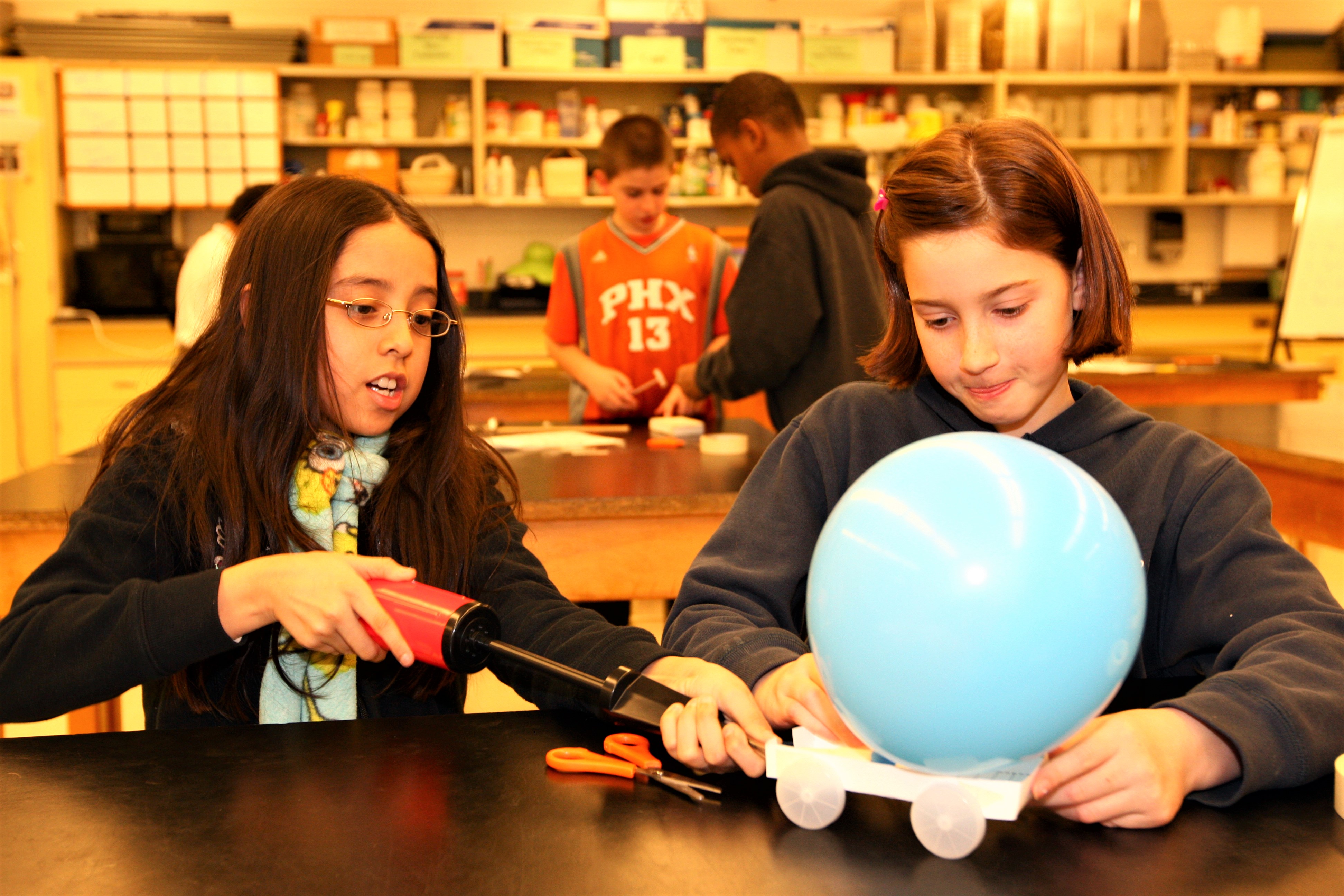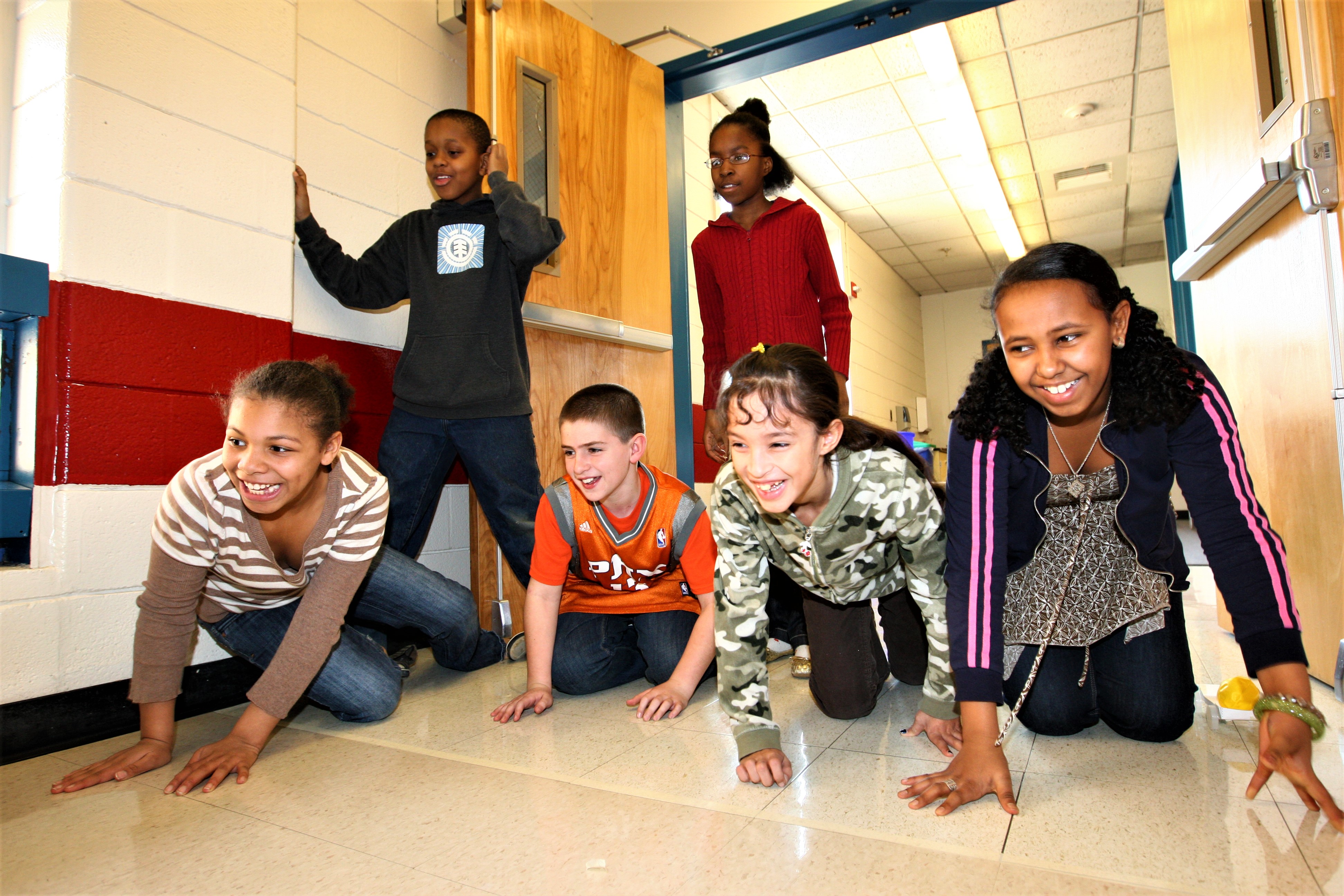Feature: A World in Motion
The following article by Mary Lord first appeared in the March, 2009 issue of ASEE’s Prism magazine.
HANDS AND MINDS
An engineering-inspired school curriculum, A World in Motion, connects standards-based theory with practical invention.
The exercise seemed simple enough: Roll a car down a ramp and measure how far it travels with different weights. Yet it could have been quantum mechanics, given the wildly divergent results that Leila Campbell’s fifth graders reported in their first brush with an engineering-inspired program called A World in Motion. And that, says the seasoned science teacher at Piney Branch Elementary School in Takoma Park, Md., is precisely the virtue of such hands-on experiences — and the profoundly teachable moments they generate when students are allowed to veer from textbooks and learn from mistakes.

Students at Piney Branch Elementary. Photo by Ned Dishman
“Isn’t that a little bizarre?” probes Campbell as heads bow over data graphs that range from deep check marks to inverted V’s. One group’s mid-weight car barely budged. Another’s zoomed. Cars even slid backward. “If we controlled all our variables,” Campbell explains, “we should have gotten the same results.” After offering theories about uneven floors and sticky wheels, the students happily regroup in the hall for new trials. This time they carefully square ramps and rulers with the linoleum and launch each run from exactly the same point. Now they’re ready to tackle force and motion — by designing and racing toy cars powered by balloon jets.
“Instead of finding answers, students end up with a lot more questions,” observes Campbell, whose classroom full of pond critters, rocks, and other captivating objects testifies to her passion for inquiry-based learning. “I’m trying to get them to think.”
Encouraging youngsters to “think outside the textbook” has long been the goal of A World in Motion, says Matthew Miller, manager of K-12 education programs at SAE International, its sponsor, formerly known as the Society of Automotive Engineers. One of the nation’s earliest hands-on physical science programs, AWIM (pronounced AY-whim) fosters teamwork and ingenuity along with math and science fundamentals by distilling the ABET-recognized engineering design experience into an interdisciplinary series of fun — and meaningful — applications. These activities are tied to the American Association for the Advancement of Science and other academic standards and structured to reinforce such core concepts as force, friction, measurement, data analysis, and critical thinking. The curriculum culminates in a capstone project, such as a competition to create the fastest car or most aerodynamic prototype glider.

Not just ‘hands on’
AWIM’s grounding in national and state learning standards sets it apart from a plethora of more recent hands-on science options. When it debuted in 1990, with hefty support from the auto and aerospace industries (General Motors CEO Rick Wagoner remains a big fan), learning by doing was a novelty. Today, many communities boast hands-on science centers, “Mad Science” after-school enrichment programs, even hands-on science birthday parties. While fun, such programs have limits as educational tools.
“Hands-on activities in isolation of context or ideas really are sort of activities for activity’s sake,” explains Francis Eberle, executive director of the National Science Teachers Association. For students to benefit, “they have to connect to a larger idea or curriculum.” Yet, he notes, “if it’s all abstract, students don’t gain an appreciation of what science can do.” Hands-on experiences help students understand the scientific process, Eberle says: “The data that they’re analyzing leads them to answers, and those answers inform their next step.”
The NSTA does not endorse programs or products, but AWIM appears to fit the association’s emphasis on connecting hands-on learning with scientific inquiry. “One of the things lots of kids struggle with is ratios,” notes Miller. Vehicles make the concept more understandable; they have gears that can be adjusted and give a physical representation of ratios. Cars also help students comprehend invisible forces like friction. “You can’t see them,” notes Miller, “but you can adjust for them.”
With its industry volunteers — GM fielded more than 1,000 engineers and other volunteers at 161 Michigan schools last year alone — AWIM also connects classroom learning to real-world science. “My students always asked when they would ever use algebra again,” recalls Miller, a former middle-school math teacher. “When you have a practitioner, it makes it clear.” AWIM does not aim solely at the gifted few. Indeed, teachers like Leila Campbell find that their academic strugglers outperform the whiz kids because they’re less locked into getting the “right” answer and less afraid of making mistakes. Assigned to draw a scale model of the hall, for instance, her top students hesitated, wanting first to know what scale they should use; lower-achieving students surged ahead — and reaped the highest marks.
AWIM’s lack of detailed instructions and its engaging format steer students toward invention. Miller recalls a “coffin car” created by South Carolina fourth and fifth graders; spring-loaded doors in the chassis tucked away the JetToy’s balloon as it deflated, reducing drag and resistance and allowing the car to coast farther. In Cleveland, a team of seventh- and eighth-grade girls turned a motorized toy car into an amphibious “turtle” by adding a waterproof power rocket. “A lot of kids think it’s a real contest and expect a paycheck or patent,” laughs Miller.
The program has evolved considerably since it began as a supplemental physical sciences curriculum for grades four, five, and six. SAE soon discovered that an activity was only as hands-on (or effective) as the teacher made it. So SAE partnered with the National Science Foundation in the mid-1990s to develop several interdisciplinary middle-school “challenges” modeled on engineering design: a motorized toy car (1996) and a glider (1998). In 2000, a fan-blown sailboat “skimmer” and the balloon-powered JetToy car joined the mix. Three years later, AWIM made the leap into high schools with an electronics and electricity curriculum.
Initially compelled to shell out for supplies, educators are now provided all materials except for big-ticket items like the fans needed to blow the sailboat skimmers. Teacher training has become a lot more hands-on, too. Instead of relying on a demonstration or manual, AWIM brings some 2,500 educators together each year to actually build a JetToy car. They see how activities link to concepts and experience the thrill of discovery and competition. “It’s those kinds of aha! moments that get teachers energized and excited,” says Miller, the director. “They can’t wait to bring it back to their classrooms.” In many American schools, where textbooks alone drive instruction, such moments remain woefully few.
Fractions have meaning
Some 4 million students in all 50 states and Canada have participated in AWIM since its inception, and several hundred thousand receive the reusable kits each year. Miller calculates it costs AWIM about $5 to reach each student.
Does AWIM deliver much bang for the bucks? The National Science Board thinks so, having given AWIM one of two 2008 awards for public service. So does Piney Branch Elementary’s Campbell. “I was the kind of kid that if I could hold it, touch it, or draw it, I could understand it,” she says, noting how she used to take apart toasters and repair her car — a practical side of science she highlights in class. “Hands-on is very concrete. Students go from doing fractions to fractions having meaning. They go from learning to use the right formula to using it with rulers to measure how far a car goes with different weights.” Signs that her students love hands-on learning: They linger after class, pop in during lunch to complete work, and do experiments together at home on weekends.
Detroit public school students who participated in AWIM scored much better than their peers on statewide test questions concerning friction and motion, and about the same or slightly better than the statewide average. A national SAE-sponsored longitudinal study due out in 2010 has found an increased interest in math and science among youngsters involved in AWIM.
Still, AWIM faces considerable hurdles. Schools can’t break from a mandated curriculum that squeezes time available for instruction in subjects other than math and reading. Local SAE chapters are ill-equipped to battle central school bureaucracies reluctant to accept what AWIM offers. And few companies match GM’s sizable commitment of volunteers, making it hard in some communities to recruit engineering professionals willing to teach a six-week course. “I haven’t had all that much luck recruiting volunteers,” acknowledges Peter Martin, a U.S. Department of Transportation engineer and AWIM coordinator for SAE’s Washington-area chapter. “I don’t know anything about schools, and neither do my colleagues. To go to a school and get volunteers to help you, to apply AWIM as it as conceived, it’s almost a full-time job.” Typical volunteers include “someone who’s retired [or who] has a kid in the school system or maybe is a guy who just likes to help kids learn,” says Martin. To attract more professionals, he suggests that AWIM cut back on the time demanded of volunteers, involving them instead in a “one-shot deal,” like a half-day workshop. “That’s about all we could pull off.”
Given the Big Three automakers’ current survival struggle, AWIM could face money problems, as well. So far, though, the program is expanding. At this year’s GM Foundation Education Day at the National Auto Show, AWIM will roll out its newest challenge — a hands-on fuel cell curriculum to engage high school students in creating energy-saving alternative engines. AWIM also is developing an early elementary school component for preschool through third grade. Due out in 2010, the program centers on simply written books with STEM themes that incorporate hands-on as well as online activities involving nozzles and lights.
Ultimately, improving science achievement will require “coordinated changes” in everything from academic standards to labs to teacher training, concludes a 2007 review by the American Educational Research Association. But hands-on programs like AWIM can help spur those changes — with a big assist from talented teachers like Leila Campbell.
Mary Lord, a freelance writer based in Washington, D.C. who specializes in education, is a frequent contributor to Prism.
Filed under: K-12 Education News, Special Features
Tags: A World in Motion, Automotive engineering, Curriculum, Prism, SAE, STEM education








